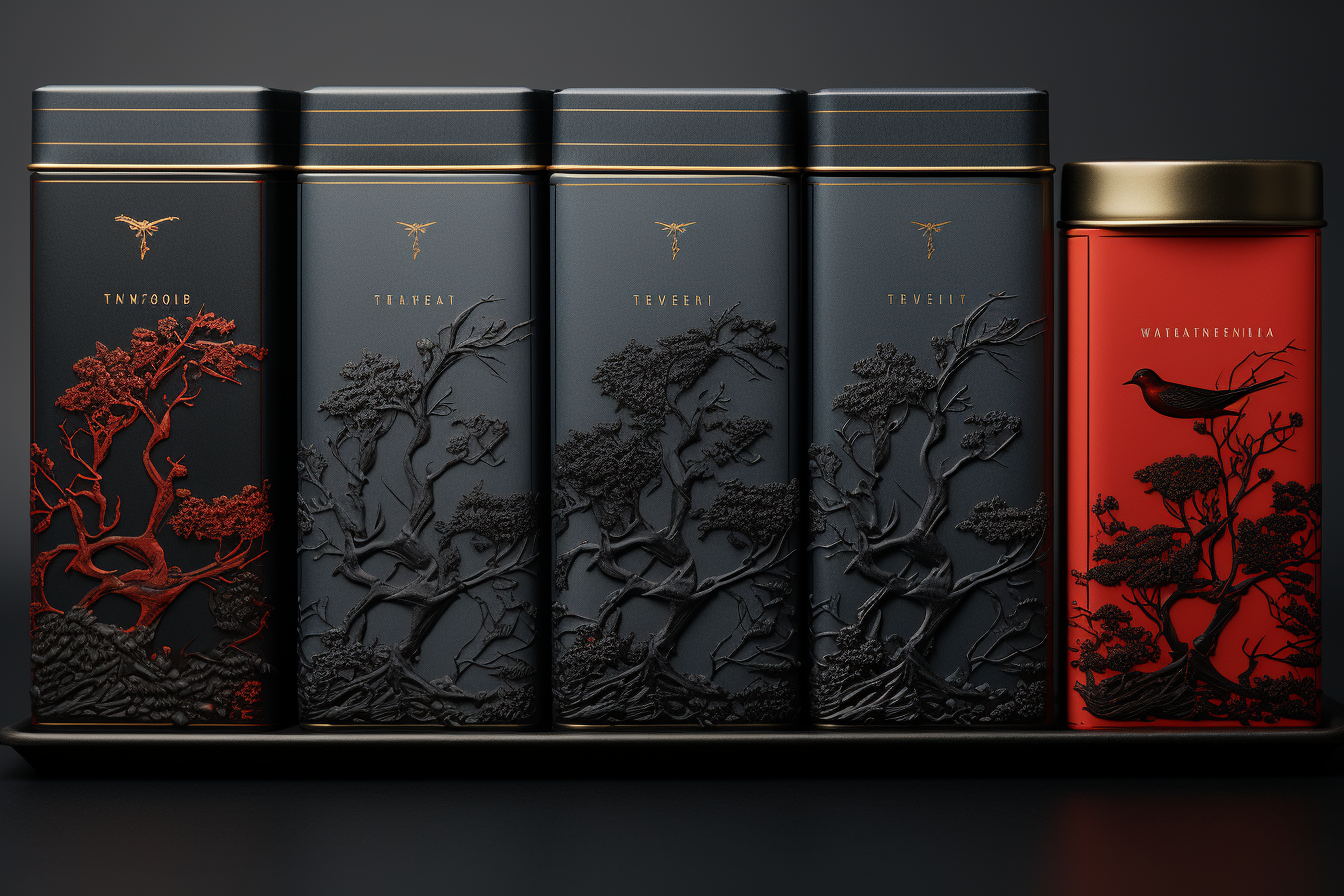Why is black such a popular brand color?
Black is a versatile color that can represent a wide range of emotions, including elegance and refinement as well as rebellion and edginess. Because of its adaptability, it is a popular choice for many firms in a variety of industries, ranging from fashion and cosmetics to technology and automobiles.

One of the primary reasons black is a popular branding color is its link with elegance and sophistication. Black is frequently used in the branding of high-end fashion labels such as Chanel and Gucci because it creates a sense of exclusivity and luxury. Black is also popular in the beauty business, with brands such as MAC and NARS employing it to create a sleek and elegant look.
Another reason black is a popular branding color is its link with power and authority. Black is generally linked with professionalism and seriousness in the business world, which is why many organizations utilize black in their branding to express a sense of authority and reliability. Companies such as Nike and Apple, for example, employ black in their logos to express professionalism and innovation.
Black is also a popular choice for brands looking to convey edginess or revolt. Brands such as Harley-Davidson and Converse employ black in their branding to convey a sense of rebellion and nonconformity to their target audience of young, rebellious consumers.

Because of its adaptability and ability to transmit a wide range of emotions and connotations, black is a popular option for branding. Black can be used to represent elegance and refinement, power and authority, rebellion and edginess, or all of the above.
The Psychological Connections of Black in Branding
Colors, including black, have a strong influence on our emotions and perceptions. When it comes to branding, the color black is related with a variety of psychological characteristics that can influence the image and attractiveness of a brand.
Sophistication and elegance are two of the most common psychological connotations with black. Black is frequently associated with refinement and luxury, and firms who utilize it in their branding can capitalize on this link to create an image of exclusivity and high-end appeal. This works especially well in the fashion and beauty industries, as black is widely used to convey refinement and luxury.

Power and authority are two other psychological associations with black. Black is frequently connected with professionalism and seriousness, which can aid a brand’s establishment as a trustworthy and dependable authority in its field. This is especially crucial for companies in the finance, legal, and technology industries, where expertise and authority are critical in establishing customer trust.
Black can also represent revolt and edginess. To generate a sense of nonconformity and edginess, brands that wish to appeal to a younger, more rebellious audience frequently utilize black in their branding. This is especially beneficial for brands in the fashion, music, and entertainment industries, where people value revolt and nonconformity.
While black can be a powerful hue for branding, firms must also consider the color’s possible negative connections. Black, for example, might be linked with pessimism and despair, which may be unsuitable for some brands. Furthermore, utilizing too much black in branding might generate an impression of heaviness or dullness, which consumers may find unpleasant.

Depending on how the color is employed and the message a company wishes to express, psychological connotations with black in branding can be both positive and negative. Understanding the psychological impact of black allows brands to properly employ this color in their branding to create a powerful and engaging image.
Brands that Effectively Use Black in Their Branding
Many firms have utilized black in their branding successfully to create a bold and engaging image. Here are a few examples of brands that have successfully used black:
Chanel: The legendary fashion label is famed for its black and white emblem, which exudes sophistication and elegance. The use of black in the brand’s logo, packaging, and advertising conveys a sense of exclusivity and high-end appeal to its target audience of affluent consumers.
Nike: The sportswear giant’s logo is a straightforward, strong black design that emphasizes professionalism and innovation. Nike’s choice of black in its trademark conveys authority and reliability, which is especially crucial in the competitive athletic apparel business.
Apple’s minimalist logo and product designs prominently incorporate black, conveying a sense of sleekness and luxury. Apple’s use of black in its branding conveys professionalism and innovation, assisting the corporation in establishing itself as a leader in the technology industry.
Harley-Davidson’s black and orange branding evokes a sense of defiance and nonconformity, which resonates with its target group of youthful, adventurous consumers. The use of black in Harley-Davidson branding gives a sense of edginess and rebelliousness that distinguishes it from other motorcycle manufacturers.
Glossier: The minimalist packaging and logo of the beauty brand showcase black prominently, creating a sense of sophistication and elegance. Glossier’s use of black in its logo gives a feeling of high-end appeal and exclusivity, which has contributed to the brand’s position as a leader in the beauty market.
Each of these firms has skillfully used black to create a bold and engaging image. The use of black in branding may be a powerful tool for developing a brand’s image and appeal, whether it conveys a feeling of sophistication and elegance, authority and trustworthiness, or rebellion and nonconformity.
Effectively Incorporating Black into Branding
There are various elements that brands should consider when using black into their branding to ensure that their usage of the hue is effective and striking.
Consider the brand’s industry and target market: Depending on the sector and target audience, black can have a variety of associations and implications. For example, black may work well for luxury fashion firms but may not work as well for a brand aimed for a younger, more whimsical audience. Understanding the brand’s target audience and industry might aid in determining whether black is an effective color choice for branding.
While black can be a powerful branding color, applying too much black might produce an impression of heaviness or dullness. To produce a unified and visually appealing design, the usage of black should be balanced with other colors and aspects in the branding.
Black can be used in conjunction with other colors to produce a visually distinctive and memorable design. matching black with white or gold, for example, might convey sophistication and elegance, whereas matching black with bright colors conveys edginess and rebellion.

Make effective use of typography: Black may be utilized well in typography to produce a bold and impactful design. However, choosing the correct font and layout is critical to ensuring that the content is legible and visually appealing.
Consider the setting: When incorporating black, keep in mind the context in which the branding will be employed. Black, for example, may not be as effective for outdoor advertising or packaging that must stand out on a crowded shelf. Brighter colors may be more effective in these situations.
Brands may build a powerful and captivating image that resonates with their target audience by considering these characteristics and utilizing black strategically and intelligently into their branding.
The Dangers of Using Black in Branding
While black can be a bold and successful branding color, there are some dangers and negatives to consider.
Unpleasant associations: The color black is frequently connected with unpleasant emotions including sadness, despair, and dread. Brands that utilize black in their branding may unintentionally generate these negative associations, which may be detrimental to the brand’s image and appeal.
Inconsistency: Black is a popular hue for branding, particularly in the fashion and beauty industries. Brands that rely too heavily on black in their branding may lack uniqueness and fail to differentiate themselves from the competition.

Cultural connotations: Depending on the place and audience, black can have a variety of cultural connotations. Black is connected with grief and death in some cultures, while it is associated with power and sophistication in others. When incorporating black into their logo, brands that operate in several countries or target diverse consumers should keep these cultural meanings in mind.
Accessibility: Individuals with specific visual impairments may find it difficult to read black text on a black backdrop or black text on a low-contrast background. Brands should make certain that the use of black in typography and design is accessible to all people.
Overuse: While black can be an excellent branding hue, too much of it can give a sense of monotony and dullness. To produce a visually appealing and impactful design, brands should balance their usage of black with other colors and design components.
By taking these potential risks and negatives into account, brands can make informed decisions on how to utilize black in branding and ensure that their branding is effective, visually appealing, and aligned with their brand’s values and messaging.
Case Studies on the Effective Use of Black in Branding
Many firms have effectively used black in their branding to establish a strong and distinctive image. Here are some instances of brands that have used black effectively in their branding:
Chanel is a luxury fashion business that has utilized black effectively in their branding for decades. The famous logo of the firm includes black letters on a white backdrop, creating a basic yet stunning design that is easily identifiable.
Nike: Nike is a sports gear company that uses black in their branding to express a sense of strength and power. The brand’s tagline “Just Do It” is frequently displayed in black font, providing a powerful and impactful design that resonates with consumers.
Apple: Apple is a technology company that uses black in its logo to express a sense of sophistication and elegance. The trademark black packaging for the brand’s products produces a clean and simple appearance that has become synonymous with the brand.
Mercedes-Benz: Mercedes-Benz is a luxury vehicle brand that has utilized black in its branding to effectively portray a sense of power and trustworthiness. The famous logo of the brand incorporates a silver star on a black background, creating a bold and powerful design that is instantly identifiable.
Adidas: Adidas is a sportswear brand that has successfully employed black in its branding to convey a sense of edginess and defiance. The classic three-stripe logo of the brand frequently comprises black stripes on a white backdrop, resulting in a striking and recognizable design that has become synonymous with the brand.
These brands have successfully used psychological associations with black to build a powerful and memorable brand image that resonates with customers. These firms have established themselves as leaders in their respective industries and have generated great brand recognition and loyalty by intentionally and thoughtfully employing black in their branding.
How to Use Black in Branding
Use black with intention: Black should be used with intention in branding. It should be utilized to communicate a specific message or feeling, not just as a default color.
Balance black with other colors: To produce a visually pleasing and impactful design, black should be balanced with other colors and design components. Too much black might give the impression of heaviness or dullness, while not enough black can fail to express the desired message or feeling.
Choose the perfect shade of black: Each shade of black has its own associations and connotations. Brands should select the shade of black that best represents their beliefs and messaging.

Consider the following: When incorporating black, consider the context in which the logo will be employed. For formal occasions or premium brands, for example, black may be more effective, whereas brighter colors may be more beneficial for casual brands or outdoor advertising.
Iterate and test: Brands should test their usage of black in branding and iterate based on consumer response. This might help to guarantee that the branding is effective and that the target audience understands it.
Brands may effectively incorporate black into their branding by following these ideas to create a dramatic and compelling design that resonates with consumers. The use of black in branding may be a powerful tool for developing a brand’s image and appeal, whether it conveys a feeling of sophistication and elegance, authority and trustworthiness, or rebellion and nonconformity.










